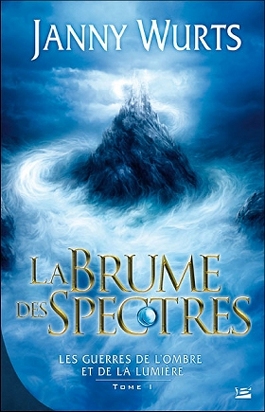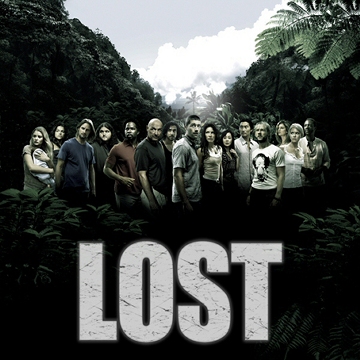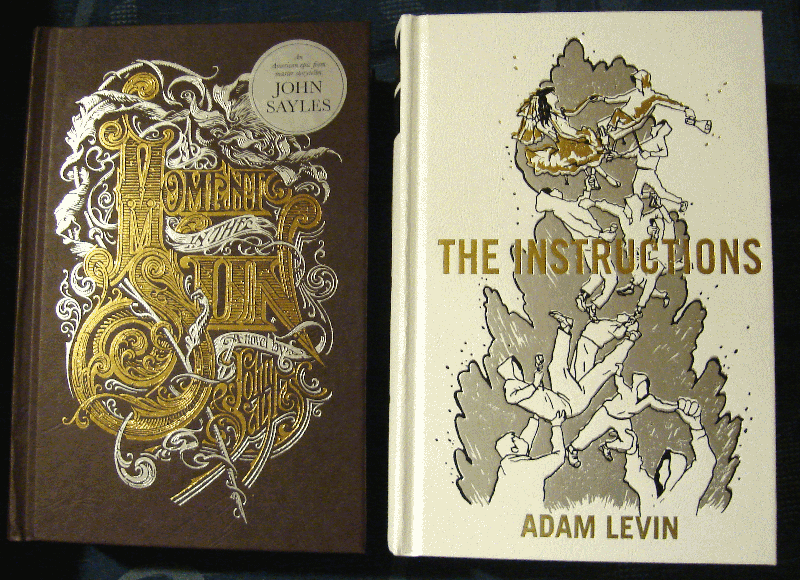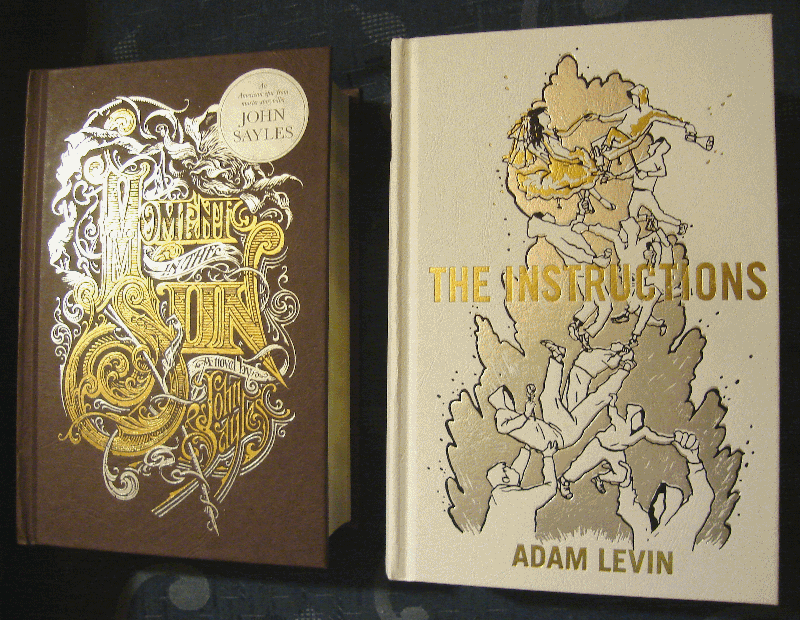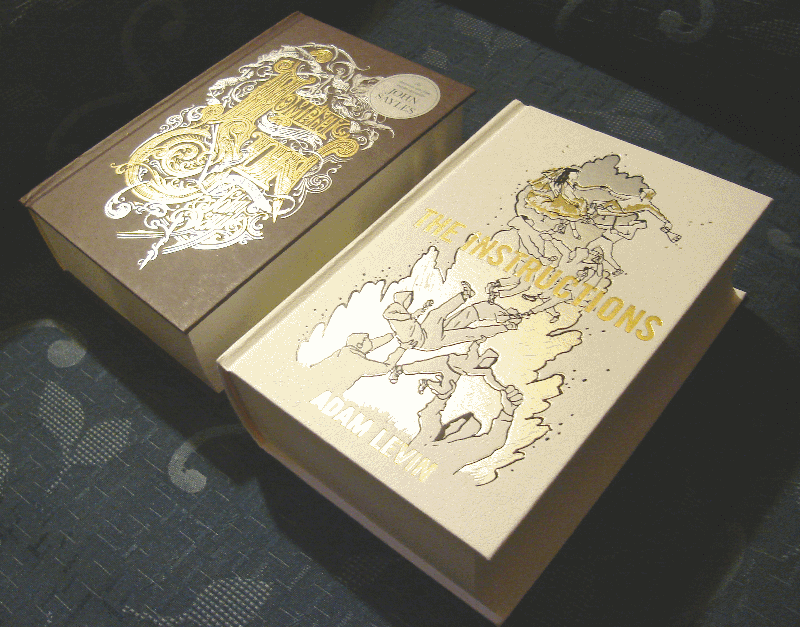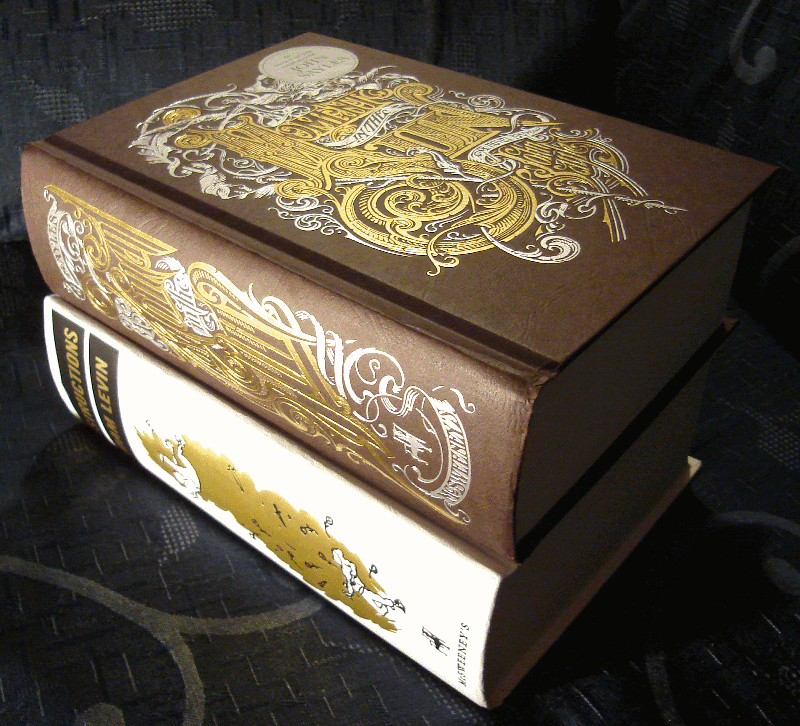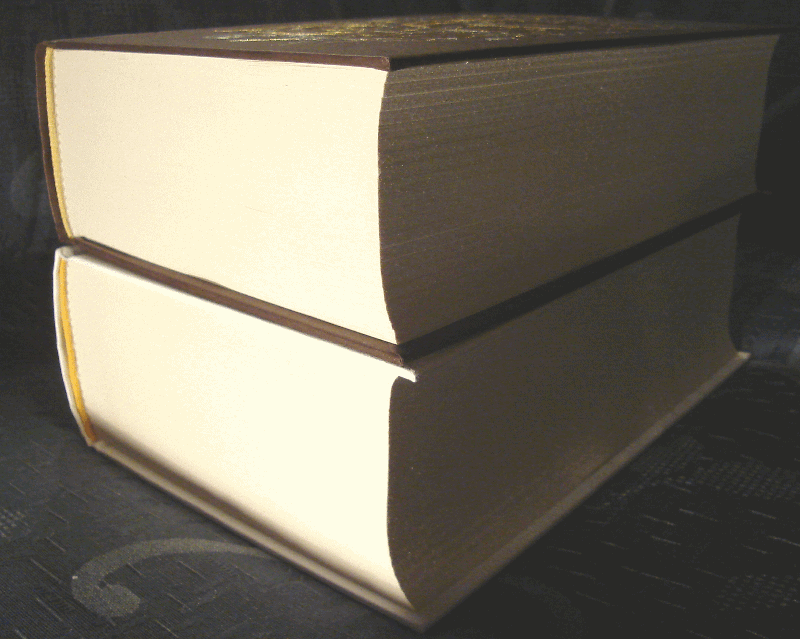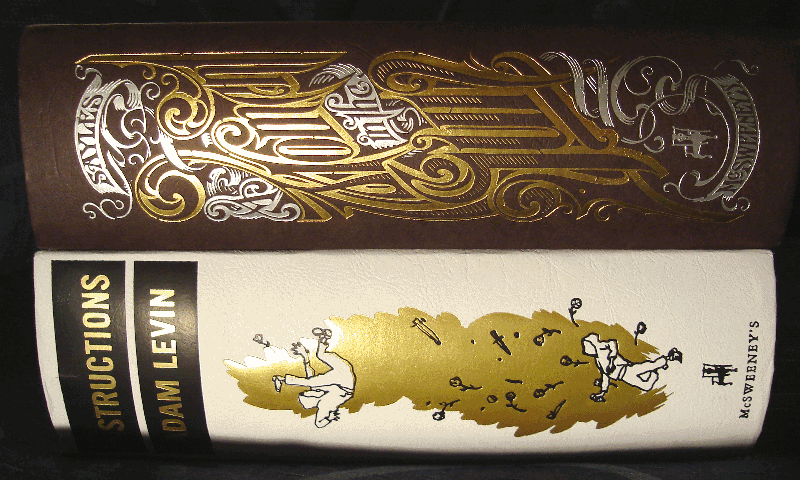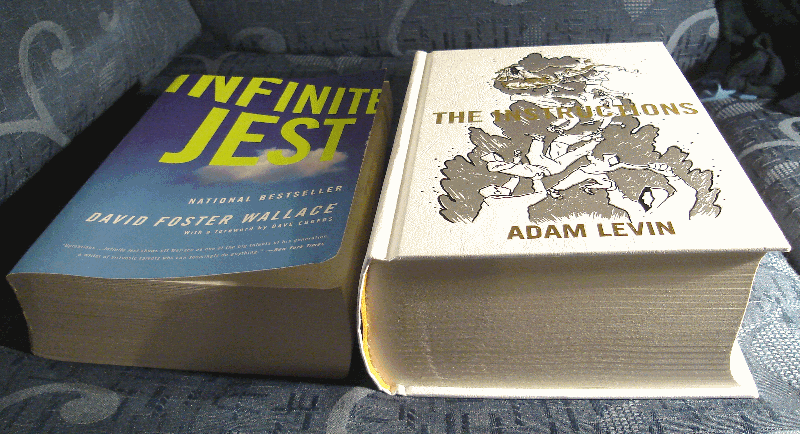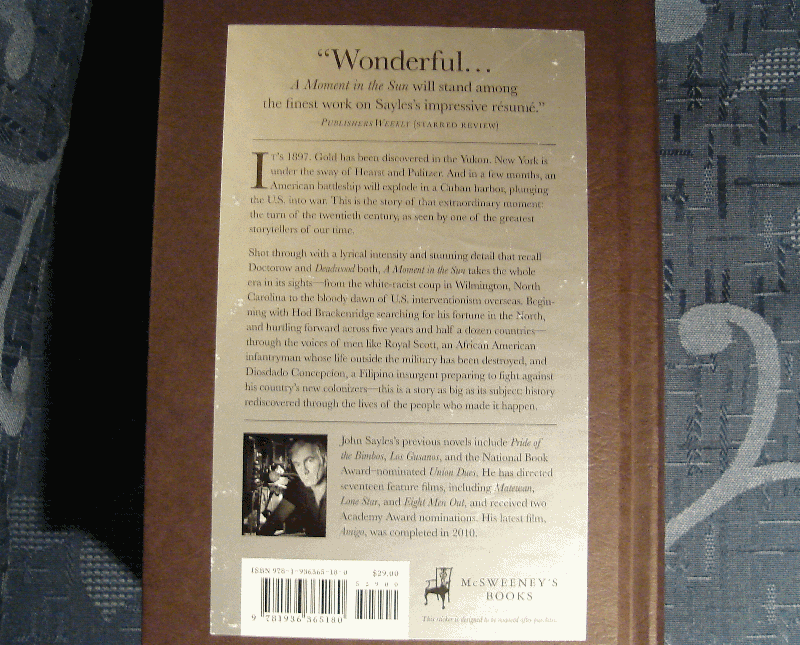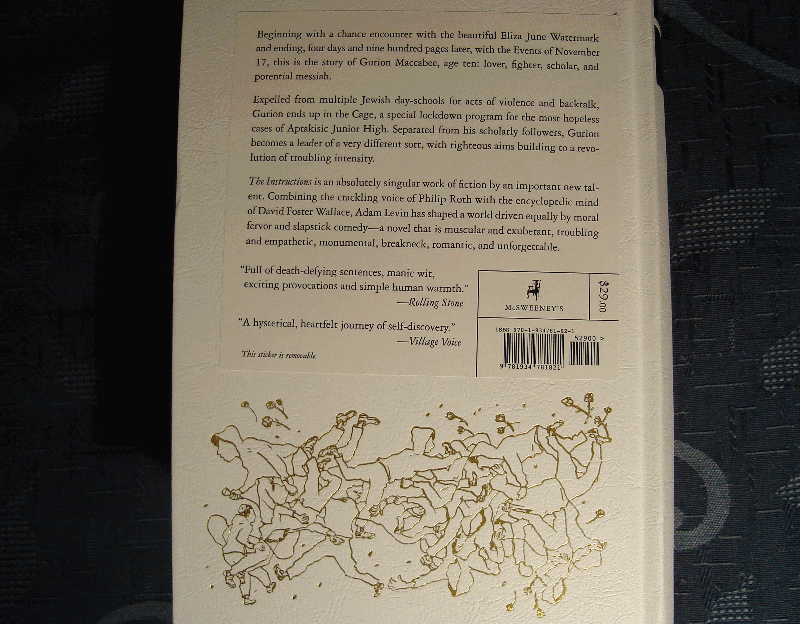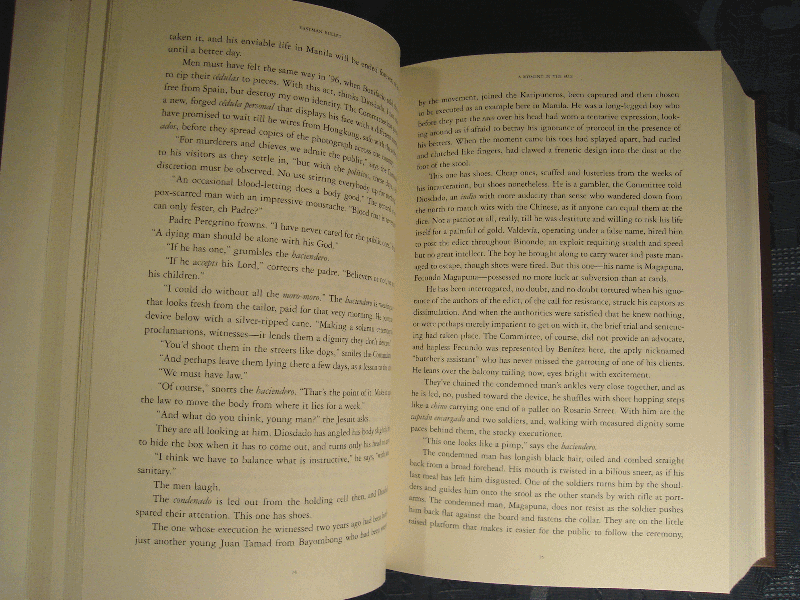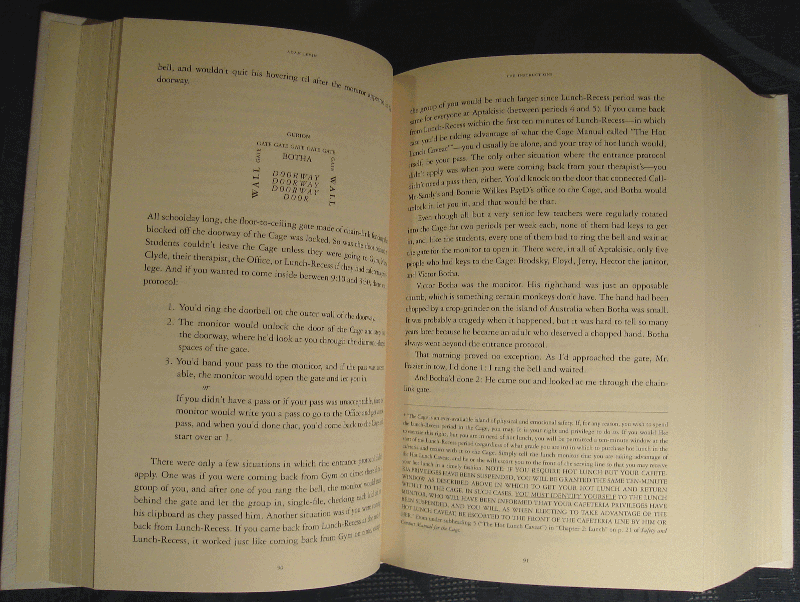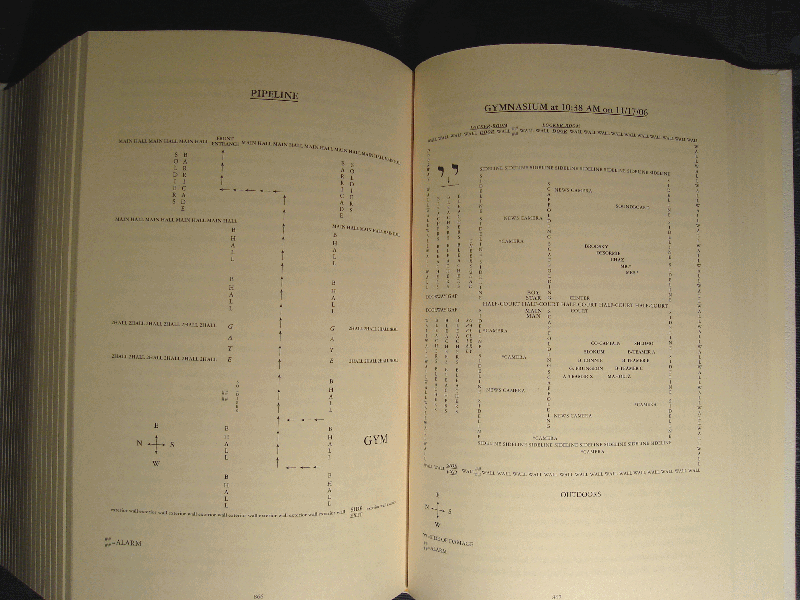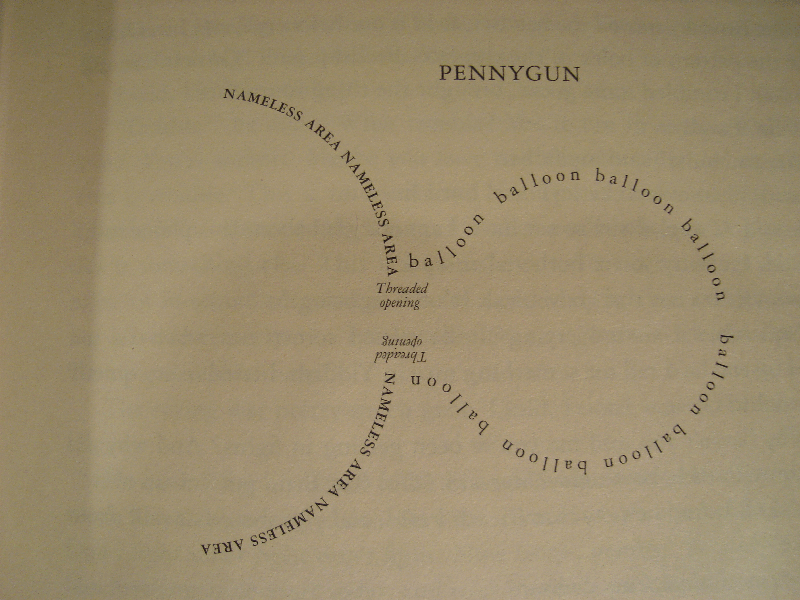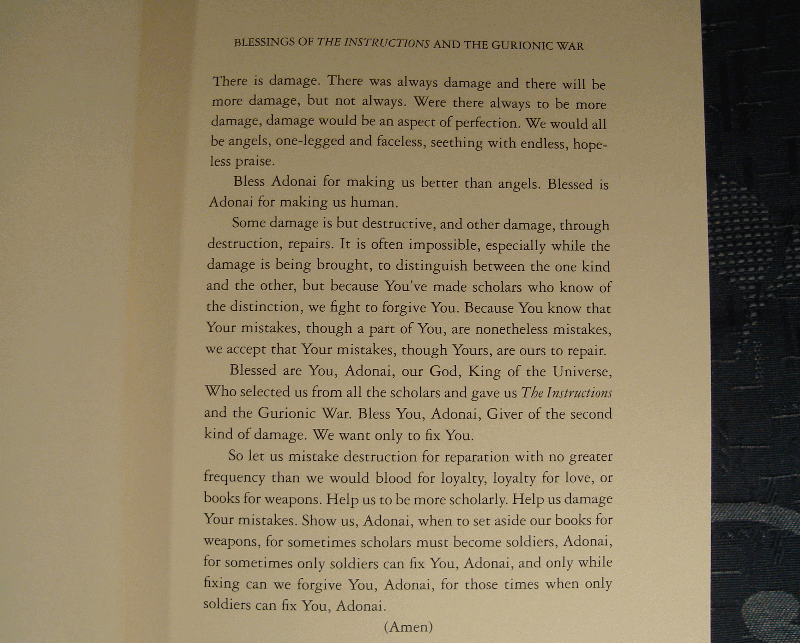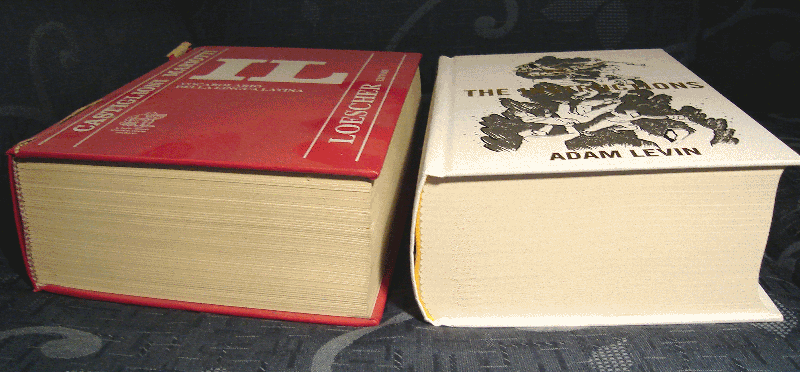 Chasing red herrings in the hope they lead somewhere. But the number of overlapping analogies and returning ideas is quite amazing. As usual, when things make TOO MUCH sense, I label them as “consolatory”, and so unreliable and most likely false.
Chasing red herrings in the hope they lead somewhere. But the number of overlapping analogies and returning ideas is quite amazing. As usual, when things make TOO MUCH sense, I label them as “consolatory”, and so unreliable and most likely false.
The journey through Post-modernism led me beyond, then back in, as in a loop. Another starting point was again provided by mass-entertainment, Fringe (the TV series). This time it was a frame, specifically episode 12 of the third series. It briefly shows some books belonging to William Bell (a character in the series). The first and last are too out of focus to recognize, but the others are explicitly shown and one of these two is a recurring book, as it was also shown in LOST. The curious fact is that I also owned some of those books:
– A Separate Reality – Carlos Castaneda
– The Second Ring of Power – Carlos Castaneda
– In the Wake of Chaos – Stephen H. Kellert
– Gödel, Escher, Bach – Douglas R. Hofstadter
– The Tao of Physics – Fritjof Capra
I own “Gödel, Escher, Bach” and a book of Castaneda not on that list: “The Art of Dreams”. The interesting part is the links between these books and some of what I wrote in my previous post. Chasing after magic, spirituality and metaphysics means getting lost very easily, waste a lot of time and get sidetracked without gaining anything really useful. I’ve always been a curious skeptic, and so I’ve dabbled here and there with these kinds of studies in my life, without getting a whole lot out of them. Often they are empty lures. This time I think I have a better orientation system I’ve built. I know where to place things and I can separate better between the garbage and something that has some deeper relevance.
I discovered that “Gödel, Escher, Bach” has now a preface by the author done for the anniversary. My copy of the book is very old and doesn’t have it, but I’ve figured out it can be read online. Amazon preview has it, but it misses some pages, but by mixing the amazon.com preview with the amazon.co.uk one it’s possible to read the whole of it (which now resides complete in a folder on my desktop, in the case they decide to “fix” it). This preface is extremely useful, as it explains concisely “what the book is about”, and its purpose is far more important and pivotal than the title may suggest. It’s a research on consciousness, and perception as consequence (bringing back to the essence of postmodernism, as way to read and portray the world).
This book sits right beside some other studies of mine that are at the very foundation of my (scientific) “beliefs”, and they earned this position. One is Niklas Luhmann, the other, that I discover now, is Heinz von Foerster. Both build a logic system that works like math. It explains the world outside through rigorous rules that are meant to be unassailable, still very close to the original methodology of GEB (the book above). They deal directly with the partiality of the observation. They know human limits and so their systems have to exist wholly within. Systems that recursively observe themselves (which is, the recursion and “strange loops”, where the GEB believes the consciousness emerges). Two books of Heinz von Foerster I have already on the way, another I found online.
A step back to Japanese Anime. Relevant quote:
“How about I observe. Therefore the universe is. Therefore, we can say if the human beings who observe the universe hadn’t actually evolved as far as they did, then there wouldn’t be any observations and the universe wouldn’t have anyone to acknowledge its existence. So it wouldn’t really matter if the universe existed or not. The universe is because human beings know it is.”
— Itsuki Koizumi, The Melancholy of Haruhi Suzumiya
This will recur. Now follow the trail to this, skip to page 37 (this book was published in 1865 and about the ideas of a philosopher who lived at the end of 1600, someone truly postmodern then):
Everything exists in the mind that perceives it; and apart from the perceiving mind nothing exists. The real place and form of existence is in the idea. The desk I write upon, the paper I feel – they exist in my ideas, and nowhere else; and they may exist in the ideas of all others, if they only saw and felt them, at the same time. If the perceiving ego did not exist, the desk and the paper before me could not have existed. Ideas are objects of perception, and their existence is in the fact that they are perceived. Ideas are different from the mind, and yet they exist in the mind.
[…]
If it is not perceived by anybody, it does not exist; for its real existence is in the fact it is perceived by some intelligent mind.
Now something more recent. “Radical constructivism: a way of knowing and learning” By Ernst von Glasersfeld.
What is radical constructivism? It is an unconventional approach to the problem of knowledge and knowing. It starts from the assumption that knowledge, no matter how it is defined, is in the heads of persons, and that the thinking subject has no alternative but to construct what he or she knows on the basis of his or her own experience. What we make of experience constitutes the only world we consciously live in. It can be sorted into many kinds, such as things, self, others, and so on. But all kinds of experience are essentially subjective, and though I may find reasons to believe that my experience may not be unlike yours, I have no way of knowing that it is the same. The experience and interpretation of language are no exception.
Heinz von Foerster follows similar ideas:
”Objects and events are not primitive experiences. Objects and events are representations of relations. Since ‘objects’ and ‘events’ are not primary experiences and thus cannot claim to have absolute (objective) status, their interrelations, the ‘environment’ is a purely personal affair, whose constraints are anatomical or cultural factors. Moreover, the postulate of an ‘external (obective) reality’ disappears to give way to reality that is determined by modes of internal computations.”
Only he clings more to mathematics and sometimes the (my) brain can’t compute:
Assume a finite universe, U0, as small or as large as you wish, which is enclosed in an adiabatic shell which separates this finite universe from any “meta-universe” in which it may be immersed. Assume, furthermore, that in this universe, U0, there is a closed surface which divides this universe into two mutually exclusive parts: the one part is completely occupied with a self-organizing system S0, while the other part we may call the environment E0 of this self-organizing system: S0 & E0 = U0.
Bu lets keep it to ideas that the brain can try to grasp. This from another book (whose name fits: “The Dream of Reality“):
The constructivism of Heinz von Foerster is concerned with the convergence of two central themes: 1) how we know what we know, and 2) an abiding concern of the world and its humanity. For the constructivist, the dreams of reason denote a common denominator running through our language and logic, manifest as a wish for what we call “reality” to have a certain shape and form. The wish has several dimensions.
First we wish reality to exist independently of us, we who observe it. Second, we wish reality to be discoverable, to reveal itself to us. We wish to know its secrets, i.e., how it works. Third, we wish these secrets to be lawful, so we can predict and ultimately control reality. Fourth, we wish for certainty; we wish to know that what we have discovered about reality is true.
Radical constructivism challenges this wish, thus taking on the unpopular job of shattering the fantasy of an objective reality. Constructivists argue that there are no observations — i.e., no data, no laws of nature, no external objects — independent of observers. The lawfulness and certainty of all natural phenomena are properties of the describer, not of what is being described. The logic of the world is the logic of the description of the world.
Constructivism identifies, for all who care to look through the lens of its epistemology, the limits of what we can know.
But is this “bias” just the result of subjective, limited perception (and so the impossibility of breaking the shell and see what’s outside), or there’s a method to it, a purpose? That’s exactly the point that divides science from metaphysics. But it is the science itself leading to that edge and then leaving you alone. Science has a direction, it leads there and then surrenders. So I make this leap and cross to a less orthodox book: Initiation Into Hermetics, by Franz Bardon.
Man is the true image of God; he has been created in the likeness of the universe. Everything great to be found in the universe is reflected, in a small degree, in man. For this reason, man is signified as a microcosm in contrast to the macrocosm of the universe. Strictly speaking, the entire nature manifests itself in man.
It forms itself a loop, a recursion. Bringing back to that pivotal idea of conscience revealed by the GEB. The “strange swirl”. It is in nature and it is in us.
Kabbalistic ideas essentially rely on the same tenet.
These ideas can even be brought to their limits. For example by von Foerster himself:
”At any moment we are free to act toward the future we desire. In other words, the future will be as we wish and perceive it to be. This may come as a shock only to to those who let their thinking be governed by the principle that demands that only the rules observed in the past shall apply to the future. For those the concept of ‘change’ is inconceivable, for change is the process that obliterates the rules of the past.”
And while I’m unsure to what extent he intends this, there are some (tapping from Kabbalistic ideas, that are at the foundation of reality as a “fake” illusion) that intend it literally: Neville Goddard.
The Power of Awareness
I AM is the self-definition of the absolute, the foundation on which everything rests. I AM is the first cause-substance. I AM is the self-definition of God.
I AM hath sent me unto you.
I AM THAT I AM.
Be still and know that I AM God.
[…]
Can man decree a thing and have it come to pass? Most decidedly he can! Man has always decreed that which has appeared in his world and is today decreeing that which is appearing in his world and shall continue to do so as long as man is conscious of being man. Not one thing has ever appeared in man’s world but what man decreed that it should. This you may deny, but try as you will you cannot disprove it, for this decreeing is based upon a changeless principle. You do not command things to appear by your words or loud affirmations. Such vain repetition is more often than not confirmation of the opposite. Decreeing is ever done in consciousness. That is; every man is conscious of being that which he has decreed himself to be. The dumb man without using words is conscious of being dumb. Therefore he is decreeing himself to be dumb.
When the Bible is read in this light you will find it to be the greatest scientific book ever written. Instead of looking upon the Bible as the historical record of an ancient civilization or the biography of the unusual life of Jesus, see it as a great psychological drama taking place in the consciousness of man. Claim it as your own and you will suddenly transform your world from the barren deserts of Egypt to the promised land of Canaan.
But in his own thinking this omnipotent “free will” is not everything. Beside “The Law” (what I’ve quoted), there’s another part: “The Promise”. “Not one shall be lost in all my holy mountain.” Meaning that there’s a purpose that drives all things. In the end God is waiting at the end, waiting that you learn and go through that path, however long it will take you (another idea coming from Kabbalah).
And this idea, of two kinds of perspective (and realities), one short term, the other long-term, recurs into that wonder that is The Red Book, by Carl G. Jung (this requires youtube).
The overall theme of the book is how Jung regains his soul and overcomes the contemporary malaise of spiritual alienation. This is ultimately achieved through enabling the rebirth of a new image of God in his soul and developing a new worldview in the form of a psychological and theological cosmology.
Jung:
If I speak in the spirit of this time, I must say: no one and nothing can justify what I must proclaim to you. Justification is superfluous to me, since I have no choice, but I must. I have learned that in addition to the spirit of this time there is still another spirit at work, namely that which rules the depths of everything contemporary. The spirit of this time would like to hear of use and value. I also thought this way, and my humanity still thinks this way. But that other spirit forces me nevertheless to speak, beyond justification, use, and meaning. Filled with human pride and blinded by the presumptuous spirit of the times, I long sought to hold that other spirit away from me. But I did not consider that the spirit of the depths from time immemorial and for all the future possesses a greater power than the spirit of this time, who changes with the generations. The spirit of the depths has subjugated all pride and arrogance to the power of judgment. He took away my belief in science, he robbed me of the joy of explaining and ordering things, and he let devotion to the ideals of this time die out in me. He forced me down to the last and simplest things.
The spirit of the depths took my understanding and all my knowledge and placed them at the service of the inexplicable and the paradoxical.
To note that Jung was convinced that what he wrote and drew was not a product of his own conscience and imagination, but that it was some kind of alien or external knowledge that seeped in, to the point that he questioned his own sanity.
In 1913 at the age of thirty-eight, Jung experienced a horrible “confrontation with the unconscious”. He saw visions and heard voices. He worried at times that he was “menaced by a psychosis” or was “doing a schizophrenia.” He decided that it was valuable experience, and in private, he induced hallucinations, or, in his words, “active imaginations.” He recorded everything he felt in small journals. Jung began to transcribe his notes into a large, red leather-bound book, on which he worked intermittently for sixteen years.
In the end, he believed that this book came out of the “collective unconscious”, or Akashic Record. Make of this what you will, but it is interesting how many ideas in it recur and resonate with the rest.
All this oddly brought me back to Malazan and Erikson’s work. Because that’s not truly “fantasy secondary world”, but more an internal, symbolic landscape. Something of the mind. And in particular, it is not “alien” or fabricated as we may naturally intend it. It mimics and reflects more our world than what one assumes. One tenets of that work is about the disparate number of mythologies and beliefs specific to each population. “Systems” that seem quite hard to conciliate with each other. Appearing contradictory. And often things reveal a common root, that was disguised by limited, blind perception. More often than not, those branches are revealed having shared origins.
Without thinking how all this applies to the Malazan world, lets think to how it applies to ours. We also have as many “mythologies” and belief systems as different populations. As this blog post makes a meager example, culture develops outwardly. It ever expands, seemingly limitless and infinite. The more you know, the more you perceive how much you miss. But counter to this outward expansion there’s another force. Which returns. You can study Castaneda’s spirituality, Yoga or other eastern philosophies, Hermeticism, the Kabbalah or whatever else, and there are often ideas that essentially recur and are only slightly refracted and distorted from one mythology to the other. A sort of common root that gives me the illusion (or possibility) that there’s a “point”. That consolatory sense of “purpose”, or idea of “God” ordering the world and having a “plan”.
The patterns of culture move outward, following an idea of progression, ever expanding knowledge. But in the end they have to return, as this Grand Design has a center, and that is “man”. We cannot transcend ourselves (as illustrated above). And through ourselves we perceive everything. Sometimes I imagine the world as an endless loop. It (itself) recurs. And every cycle is some desperate attempt to reach a “solution”. I have this idea that if God created the world, then there are essentially two possibilities. The first is the cynical one. The aquarium. The world is created to amuse. A quirk. The other is that if God created something, it is because he wished to be surpassed and not simply obeyed. That what he created could be better than himself. As a father hoping his son will have something more than he had. And so this idea of the looping world set in motion by God, trying to find the answer, and carefully programmed for that task.
Which brings back to Fringe. One theme is how the “wounded”, broken Walter is a better man. Because he’s vulnerable and so is able to better weigh his choices and their consequences. This leads to another general idea about the pains and difficulties of the real world. Without them we would all live in stasis, because there would be no stimulation (Infinite Jest also uses this theme at its core). The rules and boundaries are needed to give things a structure and establish a reaction. Relationships that bring you forward, sometimes forcefully.
I was reading Proust yesterday and this particular idea was strong. What Proust became and what made him write “In Search of Lost Time” was the product of “wounds” and weaknesses. He was suffering for the death of his mother and for his illness. But that “heightened awareness” is what gave him his sensibility and why we remember him today. Something similar could be said about David Foster Wallace. They were both great men because they were broken. Neither of them feeling privileged because of this, obviously. But this leaves also this consolatory idea of progress. That the world outside hurts so that we can eventually be “aware” and learn. It seems there are infinite paths through this kind of journey, but it is also possible they all lead to the same destination.
Proust’s work is also a world, an internal landscape with incredible complexity. Itself a microcosm explored through involuntary memory.
(here I’m doing a translation of a Preface and Proust’s words, so excuse the suckyness)
He was then choosing isolation, after his life deemed to leave him alone; he was withdrawing from the world, so that another, the internal one, would freely take shape; he was shutting himself, like Noah, inside an ark, to save himself from the Great Flood outside, but also to be able to observe and understand better what was outside. He was examining obsessively a number of themes about his soul and his body, memory and oblivion, waking life and dreams, will and inactivity.
[…]
He had to cohabit with his illnesses. After all, if that intermittence of death, presented to him as suffocation, was stealing from him the hope of life, it is also true that it was giving him a kind of second sight that let him see what others couldn’t. “Only pain lets you observe and learn and break down those structures that otherwise you wouldn’t understand. A man that, every night, would fall asleep like a stone on his bed and wouldn’t live till the moment he had to wake up, would that man think of making, if not big discoveries, at least some small observations about sleep? He’s barely aware of the act. Some insomnia wouldn’t be useless to appreciate sleep, to throw a ray of light in such darkness. A memory without flaws wouldn’t be a powerful stimulant to study the phenomena of memory.”
So seclusion and sickness, freeing him from the world and social life, offered Proust the occasion to analyze his life and the human passions. And the moments of oblivion, the emptiness, the confusion of the past, far from thwarting the memory, would infuse it a new impetus and a rare expansive strength.

 Chasing red herrings in the hope they lead somewhere. But the number of overlapping analogies and returning ideas is quite amazing. As usual, when things make TOO MUCH sense, I label them as “consolatory”, and so unreliable and most likely false.
Chasing red herrings in the hope they lead somewhere. But the number of overlapping analogies and returning ideas is quite amazing. As usual, when things make TOO MUCH sense, I label them as “consolatory”, and so unreliable and most likely false. This book, and series, is particular to begin with because it’s very rare to see discussed in the usual places. It could appear as some old series buried and forgotten, written by a writer that was well known at one point but didn’t quite make into the Big Names that continue to be relevant. Instead this is a series “in the making”, right now. Series’ name is “The Wars of Light and Shadow” and will be completed (it will) in 11 volumes. The 9th comes out in October of this year and usually one can look forward to a two-years gap between each volume. I tend to have quite a bit of trust in the writer as I’ve read in her forums and interviews that she never strayed from her original plan and is strongly against series that “sag or sprawl”, as well as cliffhangers at the end of the book. In fact this series is structured in five different arcs, with each giving closure to the story at hand (this is true for the first book, that makes a single arc on its own).
This book, and series, is particular to begin with because it’s very rare to see discussed in the usual places. It could appear as some old series buried and forgotten, written by a writer that was well known at one point but didn’t quite make into the Big Names that continue to be relevant. Instead this is a series “in the making”, right now. Series’ name is “The Wars of Light and Shadow” and will be completed (it will) in 11 volumes. The 9th comes out in October of this year and usually one can look forward to a two-years gap between each volume. I tend to have quite a bit of trust in the writer as I’ve read in her forums and interviews that she never strayed from her original plan and is strongly against series that “sag or sprawl”, as well as cliffhangers at the end of the book. In fact this series is structured in five different arcs, with each giving closure to the story at hand (this is true for the first book, that makes a single arc on its own).